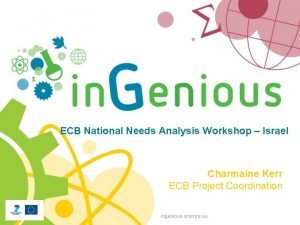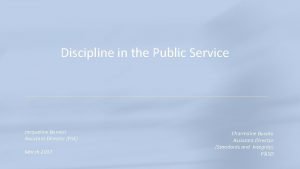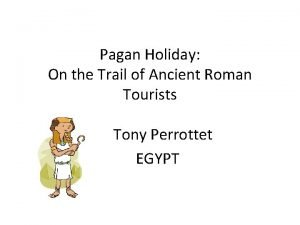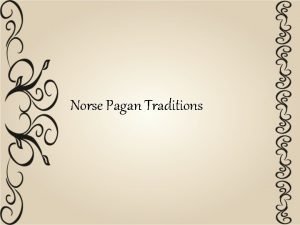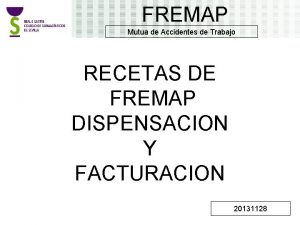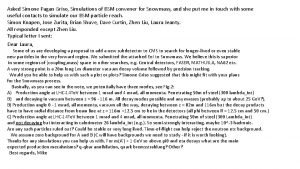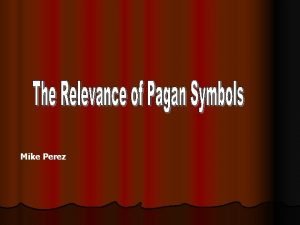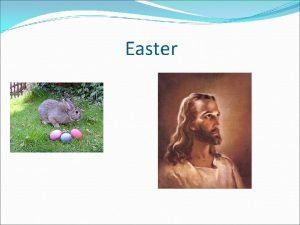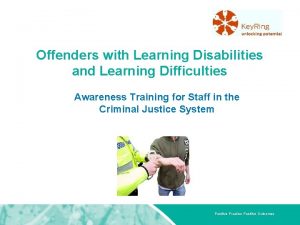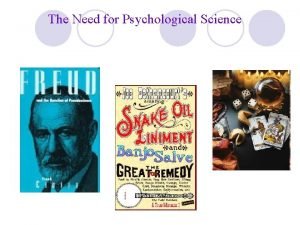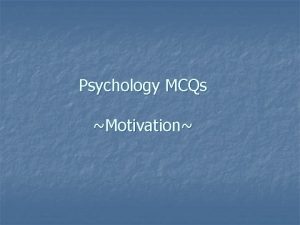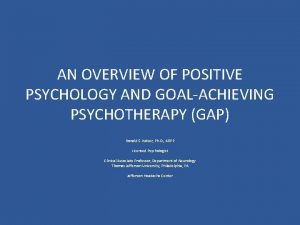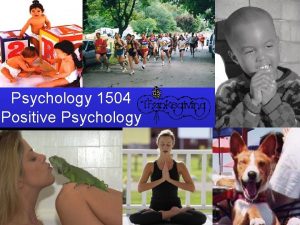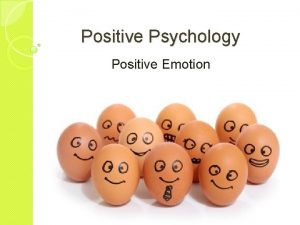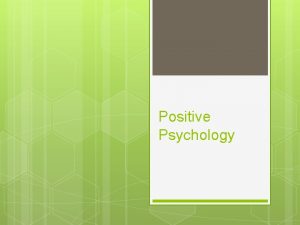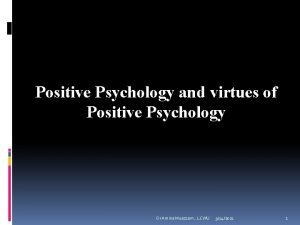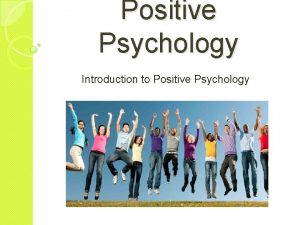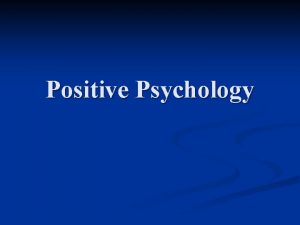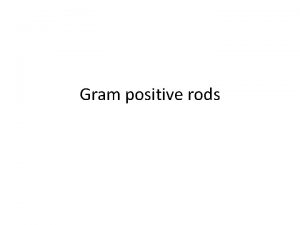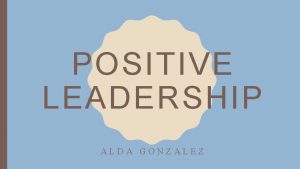POSITIVE PAGAN PSYCHOLOGY Dr Charmaine Sonnex University of






![Luhrmann (1989) One officer […] said she is ‘not there’ when the ritual is Luhrmann (1989) One officer […] said she is ‘not there’ when the ritual is](https://slidetodoc.com/presentation_image_h/32b2209a8847101e9684e7f213f50760/image-7.jpg)











- Slides: 18

POSITIVE PAGAN PSYCHOLOGY Dr. Charmaine Sonnex University of Buckingham

Paganism • Love for and kinship with nature • A positive, self-directed morality • Recognition of the Divine, which transcends gender

FLOW AND THE PAGAN RITUAL EXPERIENCE

Spells and ritual • Mental exercise • Raising, programming, and sending of energy • Altered state of consciousness is an integral aspect

Flow • Intense and focused concentration • Merging of action and awareness • Loss of reflective self-consciousness • A sense that one can control one’s actions • Distortion of temporal experience • Autotelic activity • Activity stretches one’s existing skills; one’s capacities are not over-matched or underutilised • Clear proximal goals and immediate feedback about the progress that is being made (Nakamura & Csikszentmihalyi, 2002)

The Phenomenology of Ritual specifically in rituals you’re focussing on things (Donkey) people use ritual…because it makes it easier to…focus on the intent (Greenwitch) the one’s that do work seem effortless (Rhiannon) “We do what we do in symbol and in miniature” (Yarrowwitch) you’ve got to believe that you can do it and that it’ll happen, if you don’t actually think it’s going to work then it won’t, but if you’re absolutely certain it’s going to work then it will. ” (Yarrowwitch)
![Luhrmann 1989 One officer said she is not there when the ritual is Luhrmann (1989) One officer […] said she is ‘not there’ when the ritual is](https://slidetodoc.com/presentation_image_h/32b2209a8847101e9684e7f213f50760/image-7.jpg)
Luhrmann (1989) One officer […] said she is ‘not there’ when the ritual is good: she becomes a ‘channel’ for the forces. For William […] When the rite was good, it felt as if something was acting through him and that he himself was absent. In such rituals his normal sense of space and time alters, and he knows that the only things of consequence lie within the confines of the rite. Magicians will ‘feel’ the power flowing, ‘feel’ the current run around the circle. They often assert that they know whether rituals raise any power because they can sense power intuitively during the ritual

Ezzy (2014) ‘Csikzentmihaly’s account of flow is very similar to the liminal experience of participants at Faunalia. The rituals create an experience of unified action and awareness in which the focus of participants is wholly and completely on the ritual. There is a participatory acceptance of the ritual accompanied by a sense of confidence in one’s self to do what is required. ’

Summary • The conditions necessary for flow to occur are the same as those necessary for powerful and effective Pagan ritual • The phenomenology of Pagan rites shares all the key features of the phenomenology of flow • The aim of Pagan ritual is to cultivate an ASC in order to raise and manipulate energy, this ASC is flow. Flow is a fundamental aspect of Pagan ritual, without it rites feel empty and powerless

HAPPINESS, NATURE CONNECTEDNESS, AND RELIGIOUS/ SPIRITUAL BELIEFS

NC and Happiness • Pritchard, Richardson, Sheffield, & Mc. Ewan (under review) • NC & Eudamonic wellbeing = r=0. 23 • 20 studies (n=4758) • Moderate effect size found for Personal Growth • NC & Hedonic wellbeing = r=0. 19 • 30 studies (n=11638) • Capaldi et al (2014) • NC & Hedonic wellbeing r= 0. 18 • 30 studies (n=853) • Strongest effects for vitality, positive affect, and life satisfaction

Our hypothesis 1. Individuals identifying as Pagan will have higher levels of nature connectedness, biophilic values and childhood experiences of nature. 2. Individuals with higher levels of nature connectedness, will have higher levels of biophilic values, childhood experiences of nature and happiness.

Biophilic values Lumber, Richardson, & Sheffield

Questionnaires Nature Connectedness • Connectedness to Nature (trait) scale • (Mayer and Frantiz, 2004) • Nature Relatedness Scale • (Nisbett, Zelenski, & Murphy, 2009) Biophilic Values Happiness • The Biophillic Values Scale • (Lumber, Richardson & Sheffield, 2017) • Childhood experiences of Nature Scale • (Wells & Lekies, 2006) • Psychological wellbeing scale • (Ryff, 1989)

Preliminary Results • N=137 • Abrahamic = 21 • MANOVA: F (54, 354) = 2. 057, P= <. 001, η 2=. 239 • Pagan = 31 • Atheist = 57 • Agnostic = 28 • ANOVAs; (P=. 01) Scale F Sig. Partial Eta Squared Childhood Experiences of Nature 5. 193 . 002 . 015 Connectedness to Nature Scale 12. 077 . 000 . 214 Biophillic Values- Naturalistic 6. 436 . 000 . 127 Biophillic Values- Symbolic 22. 358 . 000 . 335 Biophillic Values- Humanistic 10. 834 . 000 . 196

Our hypothesis (redux) 1. Individuals identifying as Pagan will have higher levels of nature connectedness, biophilic values and childhood experiences of nature. • Pagans show higher levels of certain Biophilic values than other religious groups • There is a greater difference between Pagans and the non-religious than between Pagans and Abrahamic faiths 2. Individuals with higher levels of nature connectedness, will have higher levels of biophilic values, childhood experiences of nature and happiness. • There are no significant differences in happiness scores between participants

References Capaldi, C. A. , Dopko, R. L. , & Zelenski, J. M. (2014). The relationship between nature connectedness and happiness: a metaanalysis. Frontiers in psychology, 5, 976. Csikszentmihalyi, M. , & Csikszentmihalyi, I. (1975). Beyond boredom and anxiety (Vol. 721). San Francisco: Jossey-Bass. Ezzy, D. (2014). Sex, death and witchcraft: A contemporary pagan festival. Bloomsbury Publishing. Luhrmann, T. M. (1991). Persuasions of the witch's craft: Ritual magic in contemporary England. Harvard University Press. Lumber, R. , Richardson, M. , & Sheffield, D. (2017). Beyond knowing nature: Contact, emotion, compassion, meaning, and beauty are pathways to nature connection. Plo. S one, 12(5), e 0177186. Mayer, F. S. , & Frantz, C. M. (2004). The connectedness to nature scale: A measure of individuals’ feeling in community with nature. Journal of environmental psychology, 24(4), 503 -515. Nakamura, J. , & Csikszentmihalyi, M. (2002). The concept of flow. In Handbook of positive psychology. CR Snyder & SJ Lopez, Eds. : 89– 105. Pritchard, Richardson, Sheffield, & Mc. Ewan (under review) The Pagan Federation https: //paganfed. org/ Ryff, C. D. (1989). Happiness is everything, or is it? Explorations on the meaning of psychological well-being. Journal of personality and social psychology, 57(6), 1069. Sonnex, C. (2017). Extending the Non-Contact Healing Paradigm to Explore Distant Mental Interaction Effects of Pagan Healing Spells (Doctoral dissertation, The University of Northampton). Wells, N. M. , & Lekies, K. S. (2006). Nature and the life course: Pathways from childhood nature experiences to adult environmentalism. Children Youth and Environments, 16(1), 1 -24.

Thank you for listening. Any questions?
 Training ground rules
Training ground rules Charmaine kerr
Charmaine kerr Discipline essay
Discipline essay Positive psychology ap psychology definition
Positive psychology ap psychology definition Roman pagan holidays
Roman pagan holidays Norse reconstructionism
Norse reconstructionism Hak dan kewajiban dokter internship
Hak dan kewajiban dokter internship Las recetas de la mutua se pagan
Las recetas de la mutua se pagan Simone pagan griso
Simone pagan griso Cross symbol
Cross symbol Easter pagan god
Easter pagan god S. agalactiae catalase test
S. agalactiae catalase test Adding and subtracting negative numbers rules
Adding and subtracting negative numbers rules Positive practice positive outcomes
Positive practice positive outcomes Example of positive correlation in psychology
Example of positive correlation in psychology Positive psychology mcqs
Positive psychology mcqs Computer metaphor psychology
Computer metaphor psychology Concepts of positive psychology
Concepts of positive psychology Positive psychology 1504
Positive psychology 1504

